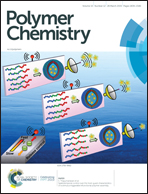Improving the flame retardancy of polyethylenes through the palladium-catalyzed incorporation of polar comonomers†
Abstract
Polyolefins, the most widely used plastics in the world, have many unique properties. However, their high flammability and poor fire resistance significantly restrict their applications in many important fields requiring fire safety. Various materials and techniques have been developed to enhance the flame retardancy of polyolefin materials. In this paper, we report the synthesis of polar functionalized polyolefins by the copolymerization or terpolymerization of ethylene with comonomers containing phosphorus, silicon, and boron atoms using a phosphine-sulfonate palladium catalyst. The incorporation of these heteroatoms can efficiently modulate the thermal properties, surface properties, and mechanical properties, and most importantly, suppress the inflammable product release of the resulting polyolefin materials in an anaerobic environment. The obtained polar functionalized polyolefins can increase the dispersion of a traditional flame retardant within the PE matrix, thereby enhancing fire safety. The peak values of the heat release rate and the total heat release were decreased by 24.5% and 4.6%. This work provides alternative strategies for improving the flame-retardant properties of polyolefin materials.



 Please wait while we load your content...
Please wait while we load your content...